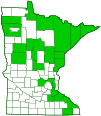Sigmoid prominent
(Clostera albosigma)
Conservation • Description • Habitat • Ecology • Distribution • Taxonomy
| Hodges # | 7895 |
||
Conservation Status |
|||
| IUCN Red List | not listed |
||
| NatureServe | N5 - Secure |
||
| Minnesota | not listed |
||
Description
Sigmoid prominent is a medium-sized, heavy-bodied, nocturnal moth. It is the most common of the four Clostera species found in Minnesota. The species name albosigma means “white S” and refers to the prominent curved marking on the forewing. Spring individuals are darker with more highly contrasting markings. Summer individuals are paler and less conspicuously marked.
The top of the head, the collar, and the top of the thorax are dark brown. The rest of the body is lighter grayish-brown. The male has a dark brown tuft at the tip of the abdomen.
The forewing is grayish-brown. The forewing is slightly concave on the costal (leading) margin and is rounded at the tip. It is crossed by four pale lines, the basal, antemedial, median, and postmedial lines. The antemedial and median lines are parallel and nearly straight. The median line is broken and does not reach the costal margin. The postmedial line is angled backward, forming a “V” with the median line at the inner margin, and forming a prominent white “S”-shaped bar approaching the costal margin. The white bar sharply delineates a dark reddish-brown or chestnut brown area. The cubitus (Cu) vein appears 3-branched.
The hindwing is nearly evenly grayish-brown without contrasting markings. The subcostal (Sc) vein and the anterior branch of the radius (R1) are fused together. The Sc+R1 and radial sector (Rs) are close together and parallel to at least the basal half of the anterior side of the discal cell then diverge.
The male antennae are comb-like with teeth-like structures on both sides. The female antennae are thread-like.
The caterpillar is stout and up to 1 3 ⁄16″ long. It has a dark, proportionally large head, and there is usually a pale brown spot above the face (frons). The thorax and abdomen are yellowish-buff and covered with downy, pale hairs (seta). Between the first thoracic segment (T1) and the second abdominal segment (A2) there are four indistinct orange or yellow lines separated by even more indistinct charcoal lines. There is a black knob on A1 that is nearly twice as large as a similar knob on A8. There is a broad, dark gray subdorsal stripe and a broad orange spiracular stripe. Mature caterpillars are seen from May to November.
Size
Total length: ⅝″ to ¾″
Wingspan: 1⅛″ to 1½″
Similar Species
Habitat
Deciduous woodlands and forests, and shrubby wetlands and fields
Ecology
Season
Mid-May to mid-August. Probably two generations per year.
Behavior
Adults are active at night and will come to lights. They rest with the wings folded tightly around the abdomen, which is raised into the air.
The caterpillar is a solitary feeder. During the day it curls up a leaf of a host plant and sticks it together with silk webbing, make a shelter where it can feed in safety. At night, it feeds in the open. Unlike all other prominents (family Notodontidae), this species does not squirt acid as a defense.
Life Cycle
Given the long flying time for this species, there are probably two generations per year in Minnesota.
The pupa overwinters.
Larva Food/Hosts
Mostly quaking aspen, but also poplar and willow, and sometimes alder, birch, maple, and elm.
Adult Food
Adults do not feed.
Distribution |
||
|
Sources 6, 7, 21, 22, 24, 27, 29, 30, 71, 75, 82, 83. Biodiversity occurrence data published by: Minnesota Biodiversity Atlas (accessed through the Minnesota Biodiversity Atlas Portal, bellatlas.umn.edu, 9/27/2025). |
|
| 9/27/2025 | ||
Occurrence |
||
Common |
||
Taxonomy
Order
Lepidoptera (Butterflies and Moths)
Superfamily
Noctuoidea (owlet moths and allies)
Family
Notodontidae (prominent moths)
Subfamily
Pygaerinae
Genus
Clostera
Subordinate Taxa
sigmoid prominent (Clostera albosigma ssp. albodigma)
sigmoid prominent (Clostera albosigma ssp. curtuloides)
Synonyms
Clostera specifica
Ichthyura albosigma
Common Names
sigmoid prominent
Glossary
Costal margin
The leading edge of the forewing of insects.
Frons
The upper front part of an insect’s face, roughly corresponding to the forehead.
Seta
A usually rigid bristle- or hair-like outgrowth on butterflies and moths used to sense touch. Plural: setae.
Spiracle
A small opening on the surface of an insect or arachnid through which it breathes.
Visitor Photos
Share your photo of this insect.
This button not working for you?
Simply email us at info@MinnesotaSeasons.com.
Attach one or more photos and, if you like, a caption.
David Israel |
||
At bug light at 22:34 |
||
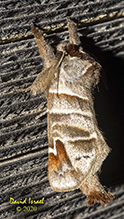 |
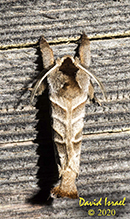 |
|
Bill Reynolds |
||
This first image it was trying to mimic a leaf and the second after I disturbed the moth from this side of the barn. |
||
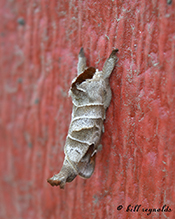 |
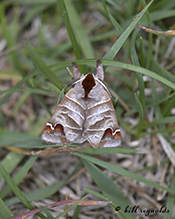 |
|
MinnesotaSeasons.com Photos
|

Slideshows
Sigmoid Prominent - Hodges#7895 (Clostera albosigma)
Andree Reno Sanborn

Visitor Videos
Share your video of this insect.
This button not working for you?
Simply email us at info@MinnesotaSeasons.com.
Attach a video, a YouTube link, or a cloud storage link.
Other Videos
Sigmoid Prominent Moth (Notodontidae: Clostera albosigma) Dorsal View
Carl Barrentine

Visitor Sightings
Report a sighting of this insect.
This button not working for you?
Simply email us at info@MinnesotaSeasons.com.
Be sure to include a location.
MinnesotaSeasons.com Sightings

